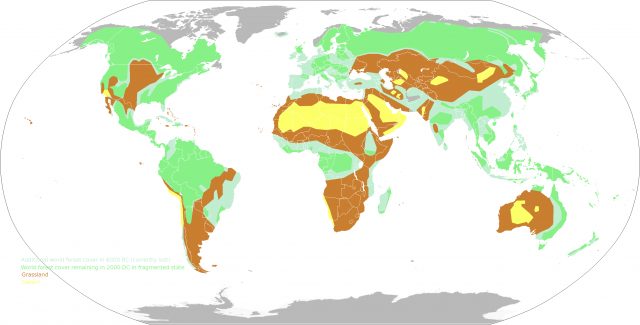vegetation zones
THE COMPOSITION OF associations among plant species tends to vary regularly across gradients of altitude, latitude, temperature, soil types, and other variables. Making use of this observation, biogeographers are able to delineate distinct sets of conditions along such gradients that reflect changes, sometimes abrupt, in the distribution of plant associations. Where two or more such changes occur, the ecology of a region may be divided into distinct vegetation zones.
The concept of the vegetation zone, alternatively called a life zone, is sometimes taken to be synonymous with the concept of the BIOME, and the terms are often used interchangeably in some scientific literature. The designation of biome, however, is more correctly applied at a higher level of generality.

The vegetation zone concept has a long history in biogeography. Its roots are usually traced to Alexander von HUMBOLDT, who devised the method of mapping isothermals (lines of equal temperature) and observed patterns of change in the distribution of organisms across isothermal gradients. In 1889, American naturalist C. Hart Merriam refined Humboldt's insight over a summer of field research in the varied landscape of the southern Colorado Plateau north of Flagstaff, ARIZONA. There, discontinuities in the composition of plant species occur abruptly and correlate well with changes in altitude. With field notes on plants covering more than 8000 ft (2,438 m) of change in altitude—a cursory examination of the GRAND CANYON extended that range, but incompletely—Merriam developed confidence in a scheme of zonation that he termed “life zones” in 1890. In addition, Merriam believed that small differences in altitude would correlate well with broad differences in latitude. Thus, the rocky, treeless area of the San Francisco Peaks above tree line, which Merriam called the “Alpine” life zone, corresponded with sub arctic regions. Merriam also noticed that boundaries between zones occur at higher altitudes on south-facing slopes than on corresponding north-facing slopes.
SEVEN LIFE ZONES
Merriam recognized seven life zones. They were, from highest to lowest: Alpine, Timberline, Hudsonian, Canadian, Transition, Upper Sonoran, and Lower Sonoran. The designations of his life zones clearly attest to his belief that the concept was applicable on a continental basis. Contemporary biogeographers and ecologists found Merriam's zones a useful, if incomplete, account of plant succession in geographical space. Over the three decades that followed, ecologists explored patterns of succession over time. The leader in this program of research was Frederick Clements. Clements developed the concept of the “climax community,” a naturally occurring, interdependent association of plants marking closure for plant succession over time. Although Clements's theory dominated biogeography for many decades, the idea of degree of interdependence in communities was challenged by contemporary biogeographers and ecologists, who argued that communities were contingent associations of plants rather than determinate biological entities in their own right. This latter view of communities has been favored since the 1950s.
VEGETATION GRADIENTS
Evolution in the concept of plant communities accompanied refinements in the concept of vegetative zones. Today, biogeographers recognize a number of gradients—temperature (across altitude and latitude), precipitation, soils and geology, among others—across which communities vary and can be usefully categorized into vegetative zones. Even so, climate gradients, especially temperature, remain important variables in the geographical distribution of vegetation zones, particularly as biogeographers uncover and monitor effects of global warming. The zone concept has also been useful in monitoring environmental degradation caused by human development and agricultural practices.
Although there is no single classification of vegetative zones on which all biogeographers and ecologists agree, most recognize variations, usually localized, of the following seven zones:
Alpine and arctic tundra and ice. This vegetative zone, found at the highest altitudes and latitudes, is all but treeless. Communities are composed of lichens, mosses, grasses, and low shrubs. Alpine tundra and arctic tundra are often considered different zones because arctic tundra plants support a range of migratory animal species and are ecologically more complex. Most of the total biomass in this vegetative zone is found in the Northern Hemisphere, north of the boreal forest.
Boreal forest. Composed, often densely, of a few species of coniferous trees, the boreal forest is extensive in the Northern Hemisphere; it covers much of CANADA and most of northern Europe and Asia. The boreal forest also extends along mountain ranges, such as the Sierra Nevada, at lower latitudes. It is usually associated with heavy snow that lingers into the summer.
Temperate deciduous forest and subtropical evergreen forest. Dominated by diverse species of summergreen, broad-leaved deciduous trees, this zone occurs in temperate regions wherever precipitation and soils are suitable. This is the dominant vegetative zone of the eastern United States, along with central to southern Europe. In warmer temperate regions, including southeastern UNITED STATES, CHINA, and JAPAN, the place of these summer-green trees is taken by evergreen deciduous species.
Temperate grasslands. A vegetative zone that includes the tall- and short-grass prairies of North America, the steppes of central Asia, and the PAMPAS of Argentina, the temperate grasslands are composed of grasses and associated nonwoody plants. In many places, temperate grasslands have been replaced by agricultural cultivars.
Desert and semidesert. Desert vegetative zones are composed of a variety of vegetative types, all of which are adapted to arid and hyperarid regions. These zones are widely distributed around the world, and most occur within 10 degrees of 30 degrees latitude, north and south.
Tropical deciduous forest and savanna. Found in the equatorial belt, tropical deciduous forest occurs in regions of moderate rainfall. The continuous canopies of these forests are distinct in composition from the more open canopies of savannas. Differences in climate, the frequency of wildfire, and relative abundance of grazing animals contribute to the distinctiveness of these zones.
Tropical rainforest. As the name implies, tropical rainforests occur in regions where temperatures are relatively stable year-round and where precipitation is abundant. Tropical rainforests are species-rich and are highly productive of biomass.